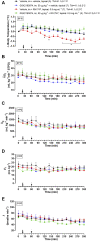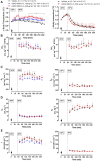Cutaneous TRPV4 Channels Activate Warmth-Defense Responses in Young and Adult Birds
- PMID: 35910562
- PMCID: PMC9337882
- DOI: 10.3389/fphys.2022.892828
Cutaneous TRPV4 Channels Activate Warmth-Defense Responses in Young and Adult Birds
Abstract
Transient receptor potential vanilloid 4 (TRPV4) channels are sensitive to warm ambient temperatures (Tas), triggering heat loss responses in adult rats in a Tas range of ∼26-30°C. In birds, however, the thermoregulatory role of TRPV4 has never been shown. Here, we hypothesized that stimulation of TRPV4 induces thermolytic responses for body temperature (Tb) maintenance in birds, and that this function is already present in early life, when the Ta range for TRPV4 activation does not represent a warm condition for these animals. We first demonstrated the presence of TRPV4 in the dorsal and ventral skin of chickens (Gallus gallus domesticus) by immunohistochemistry. Then, we evaluated the effects of the TRPV4 agonist, RN1747, and the TRPV4 antagonists, HC067047 and GSK2193874, on Tb and thermoeffectors at different Tas in 5-day-old chicks and 60-day-old adult chickens. For the chicks, RN1747 transiently reduced Tb both in thermoneutrality (31°C) and in a cold Ta for this phase (26°C), which relied on huddling behavior inhibition. The TRPV4 antagonists alone did not affect Tb or thermoeffectors but blocked the Tb decrease and huddling inhibition promoted by RN1747. For the adults, TRPV4 antagonism increased Tb when animals were exposed to 28°C (suprathermoneutral condition for adults), but not to 19°C. In contrast, RN1747 decreased Tb by reducing metabolic rate and activating thermal tachypnea at 19°C, a Ta below the activation range of TRPV4. Our results indicate that peripheral TRPV4 receptors are functional in early life, but may be inhibited at that time when the range of activation (∼26-30°C) represents cold Ta for chicks, and become physiologically relevant for Tb maintenance when the activation Ta range for TRPV4 becomes suprathermoneutral for adult chickens.
Keywords: Metabolism; body temperature; chicken; huddling; peripheral thermoreceptor; thermolysis; thermoregulation.
Copyright © 2022 Cristina-Silva, Amaral-Silva, Santos, Correa, da Silva, Fernandes, da Silva, Gargaglioni, Almeida and Bicego.
Conflict of interest statement
The authors declare that the research was conducted in the absence of any commercial or financial relationships that could be construed as a potential conflict of interest.
Figures






Similar articles
-
Hypothalamic TRPV4 channels participate in the medial preoptic activation of warmth-defence responses in Wistar male rats.Pflugers Arch. 2019 Sep;471(9):1191-1203. doi: 10.1007/s00424-019-02303-1. Epub 2019 Aug 19. Pflugers Arch. 2019. PMID: 31428866
-
TRPV4 activates autonomic and behavioural warmth-defence responses in Wistar rats.Acta Physiol (Oxf). 2015 Jun;214(2):275-89. doi: 10.1111/apha.12477. Epub 2015 Mar 17. Acta Physiol (Oxf). 2015. PMID: 25739906
-
A thermoregulatory role of the medullary raphe in birds.J Exp Biol. 2021 Mar 23:jeb.234344. doi: 10.1242/jeb.234344. Online ahead of print. J Exp Biol. 2021. PMID: 33758021
-
Effect of capsaicin on thermoregulation: an update with new aspects.Temperature (Austin). 2015 Jun 2;2(2):277-96. doi: 10.1080/23328940.2015.1048928. eCollection 2015 Apr-Jun. Temperature (Austin). 2015. PMID: 27227029 Free PMC article. Review.
-
Hyperthermia induced by transient receptor potential vanilloid-1 (TRPV1) antagonists in human clinical trials: Insights from mathematical modeling and meta-analysis.Pharmacol Ther. 2020 Apr;208:107474. doi: 10.1016/j.pharmthera.2020.107474. Epub 2020 Jan 9. Pharmacol Ther. 2020. PMID: 31926897 Review.
References
-
- Almeida M. C., Hew-Butler T., Soriano R. N., Rao S., Wang W., Wang J., et al. (2012). Pharmacological Blockade of the Cold Receptor TRPM8 Attenuates Autonomic and Behavioral Cold Defenses and Decreases Deep Body Temperature. J. Neurosci. 32, 2086–2099. 10.1523/JNEUROSCI.5606-11.2012 - DOI - PMC - PubMed
-
- Amaral-Silva L., Tazawa H., Bicego K. C., Burggren W. W. (2020). Metabolic and Hematological Responses to Endotoxin-Induced Inflammation in Chicks Experiencing Embryonic TCDD Exposure. Environ. Toxicol. Chem. 39, 2208–2220. - PubMed
LinkOut - more resources
Full Text Sources

